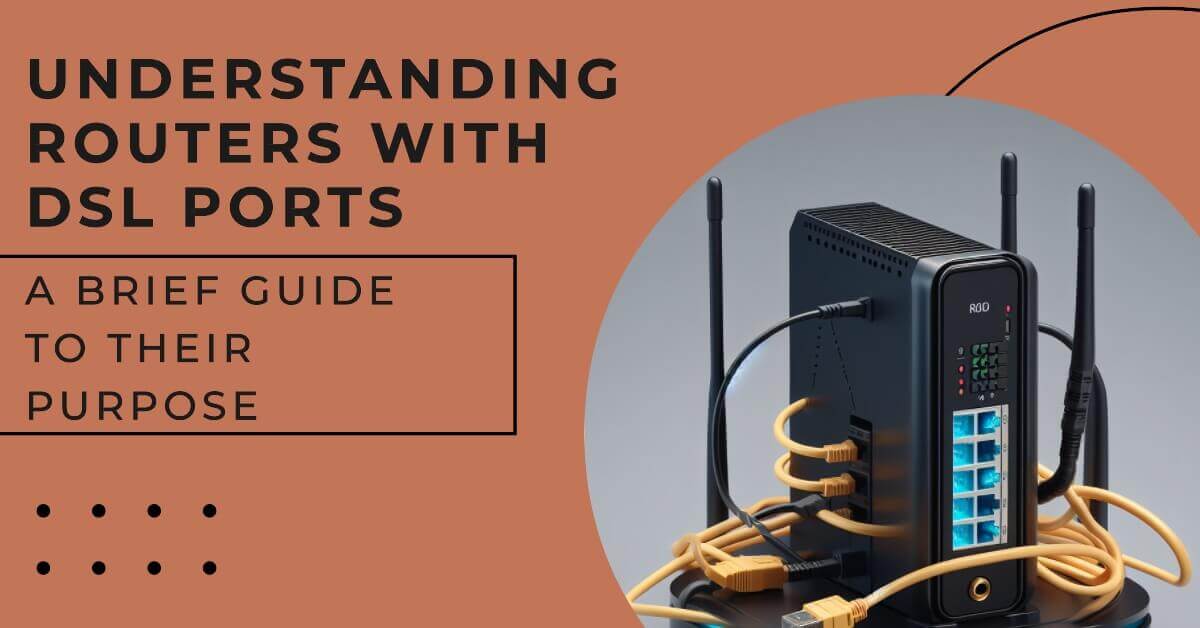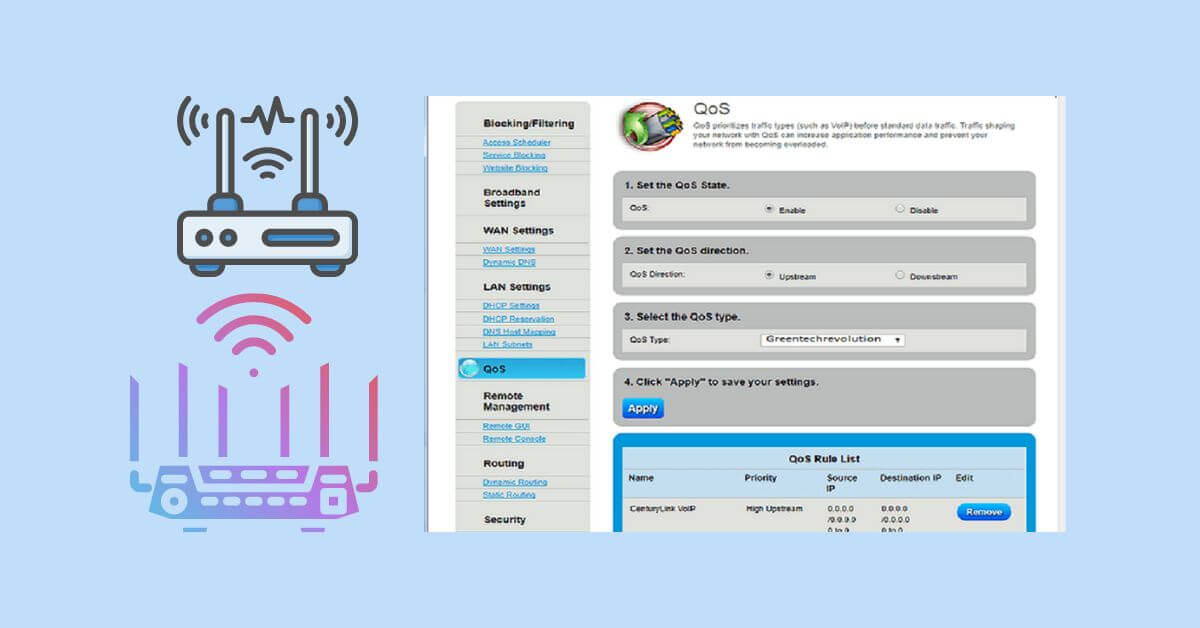A router with a DSL port is used to connect to the internet using a DSL (digital subscriber line) connection. A DSL connection uses your phone line to transmit data and provides a faster connection than traditional dial-up.
If you live in an area without access to cable or fiber-optic internet, a DSL connection may be your best option for high-speed internet. A router with a DSL port allows you to connect multiple devices to the internet and also offers additional features like parental controls and a firewall.
The router acts as a gateway between your devices and the internet, allowing for secure and stable connectivity. Moreover, it is important to note that DSL internet speeds may vary depending on your location and the quality of your phone line.
DSL Router List:
Understanding Dsl Technology
If you’re new to the world of internet connections, you might find yourself scratching your head at all the technical jargon thrown around. Dsl is one of the most common terms you’ll hear, particularly when it comes to routers. Let’s dive into what DSL is, its advantages, and how it relates to modems and routers.
Definition Of DSL
Dsl stands for digital subscriber line, and it’s a type of internet connection that utilizes existing telephone landlines to transmit data. In other words, it’s a broadband internet connection that uses copper wires in the phone line to deliver high-speed internet access.
It’s important to note that DSL connections have different speeds and bandwidth capacities and are offered by internet service providers (ISPs) based on their infrastructure.
Advantages Of DSL
DSL technology comes with several advantages that make it a popular choice among internet users. Here’s a rundown of some of its benefits:
- Faster speeds than dial-up connections at a reasonable price.
- The connection is always on, so there’s no need to dial in again.
- DSL is widely available, and you can find it in both urban and rural areas.
- You can use the phone and the internet at the same time as DSL uses a different frequency band.
Dsl Modems Vs. Routers
To access the internet using a DSL connection, you’ll need either a DSL modem or a router with a built-in DSL modem. A router with a DSL port is primarily responsible for connecting your local network to the internet and acts as a hub for all your devices to connect to the internet.
A DSL modem, on the other hand, is a standalone device that converts the signal from the telephone line into something that your computer can understand. However, many routers come with a built-in DSL modem, making them a more convenient option.
Understanding DSL technology can help you determine the right router for your needs and make the most of your internet connection. Whether you’re streaming movies, gaming, or browsing the internet, DSL technology can provide reliable and high-speed internet access.
What Is A Router?
When it comes to setting up a network, routers with DSL ports can be a helpful tool. But what is a router, exactly? A router is a device that connects multiple devices to the internet through a single modem. It does this by “routing” data packets to their intended destinations.
Here’s a closer look at routers, how they work, and the different types available.
Definition Of A Router
A router is a networking device that forwards data packets from one network to another. It does this by analyzing the destination address of each packet and forwarding it to the correct device. In simple terms, a router is like a traffic cop directing internet traffic.
Different Types Of Routers
There are two main types of routers: wired and wireless. Wired routers connect devices via ethernet cables, while wireless routers allow devices to connect wirelessly via Wi-Fi. Within these two categories, there are also several subtypes, including:
- Broadband routers: These are the most common type of routers for home use, connecting to a modem to provide internet access to multiple devices.
- VPN routers: These routers are designed to work with virtual private networks (VPNs) for enhanced security.
- Gaming routers: As the name suggests, these routers are optimized for gaming performance, providing faster speeds and lower latency.
How Routers Work
Routers use a set of protocols, such as Ethernet and TCP/IP, to communicate with devices on the network. When a device sends a data packet, the router receives it and checks the packet header for the destination ip address. The router then looks up the ip address in its routing table to determine where to send the packet next.
The packet is forwarded through the appropriate port to the next router, repeating the process until it reaches its final destination.
Overall, routers with DSL ports play an important role in connecting devices to the internet and facilitating data transfer between them. Knowing how routers work and the different types available can help you choose the right one for your needs.
What Is A DSL Router?
Definition Of A Dsl Router
A digital subscriber line (DSL) router is a type of networking device that facilitates the connection between a home or office wired network and an internet service provider (ISP) over a DSL line. It essentially acts as an interface between the user’s local network and their ISP, allowing internet traffic to flow from the network to the ISP.
Key points about DSL routers include:
- They are specifically designed to work with DSL connections, which use existing telephone lines to transmit data.
- They often have physical ports for connection to telephone lines, as well as ports for LAN and wan connectivity.
- A DSL router is typically connected to a modem or DSL port (usually built into the router), which is responsible for converting digital data into an analog signal that can be transmitted over telephone lines.
Basic Components Of A Dsl Router
A DSL router usually consists of several key components, including:
- DSL modem: As mentioned earlier, this is used to convert digital data into an analog signal that can be transmitted over telephone lines.
- Ethernet switch: This component manages the flow of data between devices on the local area network (LAN).
- Wireless access point: Some DSL routers also include a wireless access point, which allows wireless devices to connect to the network.
- Firewall: This is used to block unauthorized access to the network, keeping it secure.
- Quality of service (QoS) settings: These settings allow users to prioritize certain types of traffic (such as video streaming or online gaming) over others.
How A DSL Router Works
When a user wants to connect to the internet, their device (such as a laptop or smartphone) sends a request to the DSL router. The router then checks to see if the request is destined for a local device (such as another device on the same LAN), or if it needs to be forwarded to the internet.
If it needs to be forwarded to the internet, the router sends the request to the modem for conversion into an analog signal that can be transmitted over telephone lines.
Once the signal reaches the ISP, it is translated back into digital data and sent to its intended destination. The process works in reverse for incoming traffic – data is received by the modem, translated into digital data, and forwarded to the router for local distribution.
Overall, the DSL router plays a vital role in facilitating communication between a user’s local network and the internet, allowing for seamless internet browsing, downloading, and streaming.
Types Of Dsl Routers
When it’s about networking, the router is an essential device that plays a significant role. Routers are used to connect multiple devices to the internet or to transfer data between devices. But what is a router with a DSL port used for?
A router with a DSL port is used to connect to DSL broadband internet service. It acts as a bridge between the internet and various devices connected to the router. There are different types of dsl routers, so let’s take a closer look at them.
Wired Dsl Routers
A wired dsl router, also known as a dsl modem router, connects to the internet via a dsl phone line with the help of an ethernet cable. This type of router is easy to set up and offers reliable internet connectivity.
Here are the key points to consider:
- Supports high-speed internet connectivity.
- Offers low latency that makes it ideal for activities like gaming.
- Relatively cost-effective compared to wireless options.
- Ideal for small businesses or home networks.
Wireless Dsl Routers
A wireless dsl router offers the same capabilities as a wired router with the additional feature of wireless connectivity. It allows users to connect to the internet via wi-fi, which means that a wireless dsl router requires no cables. Here are the key points to consider:
- Offers easy connectivity by eliminating the need for cables.
- Ideal for individuals who use mobile devices, such as laptops and tablets.
- Good for large houses or offices as it provides a better range.
- Speeds may decrease with distance and obstacles.
Dual-Band Dsl Routers
Dual-band dsl routers have both 2. 4ghz and 5ghz frequency bands. Dual-band routers offer faster internet speeds, making them ideal for gaming and streaming. Here are the key points to consider:
- Offers both 2.4ghz and 5ghz bands.
- Ideal for large households with multiple devices.
- Supports high-speed internet connectivity.
- Expensive compared to wireless and wired routers.
A router with a dsl port is an essential device for connecting to dsl broadband internet services. Wired, wireless, and dual-band are different types of dsl routers, each with its unique benefits. Consider your specific requirements before purchasing a dsl router.
Features Of Dsl Routers
Dsl routers play a critical role in connecting your home devices to the internet. These devices possess a dsl port, which serves as the entry point for your internet service provider’s high-speed internet connection. Though these routers can be used for various purposes, they come equipped with several features that make them stand out from other types of routers.
Security Features
One of the most crucial aspects of a router is its ability to provide security to the devices connected to it. Security features help keep your network safe, protecting your personal and financial data from hackers. Most dsl routers come with security features such as:
- WPA, WPA2, and WEP encryption protocols help protect your network from unauthorized access.
- Built-in firewalls prevent malicious traffic from entering your network.
- VPN support allows secure access to your network from remote locations.
Quality Of Service (QoS)
Dsl routers come with a quality of service (QoS) feature that allows you to prioritize your internet traffic. With QoS, you can specify which devices should have the highest priority when using the internet, ensuring optimal performance. This feature allows you to set limits on what types of traffic take priority.
For example, you can set your gaming console to have the highest priority over your smartphone, ensuring that your game runs smoothly.
Parental Controls
Many dsl routers come equipped with built-in parental controls, making it easier for parents to enforce internet access policies. The parental controls feature allows you to block access to specific websites or restrict internet access to certain hours of the day.
The administrator can also set up user accounts to restrict access to specific devices or applications.
Port Forwarding And DMZ Support
Dsl routers are also capable of port forwarding and DMZ (demilitarized zone) support. Port forwarding allows devices outside your network to access specific services on your network. DMZ is a security feature that allows a device to be placed outside the network but still provides access to the internet.
This feature is useful when setting up a server within your network, which requires access from the internet.
Benefits Of Using A Dsl Router
A dsl router is designed to help users connect multiple devices to the internet via a dsl port. It offers several benefits that make it a popular choice for individual and business users alike. Below we will discuss some of the key advantages of using a dsl router.
Multiple Devices Can Be Connected
Dsl routers are ideal for users who have multiple devices that require internet connectivity. It is equipped with multiple LAN ports that allow you to connect different devices, such as computers, laptops, gaming consoles, smartphones, and tablets. With a dsl router, there’s no need to worry about the number of devices that need to connect to the internet; everyone in your household can enjoy internet connectivity simultaneously.
Benefits:
- Conveniently connect multiple devices to the internet simultaneously
- No need to worry about compatibility issues
- Perfect for households with multiple users
Consistent, Reliable Connection
One of the main benefits of using a dsl router is that it provides a consistent and reliable internet connection. Unlike traditional dial-up connections, which require a phone line to function, dsl routers use digital signals to establish a connection.
This results in a faster and more reliable connection, even during peak usage times.
Benefits:
- More stable and reliable internet connection
- Faster download and upload speeds
- Less likely to experience lags or buffering when streaming content
Easy To Set Up And Manage
One of the most significant advantages of using a dsl router is that it is easy to set up and manage. Most routers come with detailed instructions that even tech novices can follow. Once set up, it can be managed via a user-friendly web interface that allows you to configure the settings and monitor internet usage.
Benefits:
- Quick and straightforward setup process
- Easy to configure router settings
- User-friendly web interface for managing network settings
A dsl router is an excellent choice for users who want to connect multiple devices to the internet and enjoy a fast and consistent connection. Its ease of use and management make it a popular choice for both home and business users.
Choosing The Right Dsl Router
When it comes to dsl routers, choosing the right one can feel like a daunting task. With a variety of brands, features, and prices to consider, it’s essential to understand what you need before making a purchase. In this section, we’ll cover some considerations when choosing a dsl router, including features vs.
price and brand reputation.
Considerations When Choosing A Dsl Router
Before purchasing a dsl router, you need to be aware of the essential features that match your internet needs. Below are some points to keep in mind while selecting your dsl router:
- Speed: It is crucial to choose a router that delivers high-speed internet that matches the available internet connection in your area.
- Dsl modem integration: A dsl modem is essential for connecting to the internet via a phone line. Thus, ensure that your router has an in-built dsl modem to eliminate the need for a separate device.
- Security: A good router should include features like WPA, wpa2, spi, and a firewall to keep your network safe from hacking and cyber-attacks.
- Range: The range of a router depends on its transmission power compared to the distance. Pick a router that provides the ideal range for your home or office.
Comparison: Features Vs. Price
When selecting a dsl router, it’s essential to balance performance and price. Here’s what you need to keep in mind while comparing routers based on features vs. price.
- Features: Dsl routers vary in their features, such as guest access, QoS, parental control, and other advanced settings. It’s important to choose a router with the right features that suit your internet and networking needs.
- Price: Router prices range from around $30 to several hundred dollars depending on the features you require. A high price doesn’t always guarantee better quality, but buying a cheap router can cost you in terms of security, speed, and reliability. Thus it’s essential to strike a balance between price and features.
Brand Reputation
Brand reputation is critical when choosing a dsl router because a reputable brand is likely to deliver quality and reliable products. Some of the most reputable router brands include Netgear, Asus, tp-link, and Linksys. Choosing a brand with a good reputation ensures the safety, reliability, and durability of your router.
Choosing the right dsl router is crucial in ensuring fast, reliable, and secure internet connectivity at home or in the office. Consider the features, price, and brand reputation before making a purchase. Remember, it’s always better to invest more money in a high-quality router that delivers optimization, security, and stability than to go for a cheaper option that will compromise your internet speed, network security, and connectivity.
Setting Up Your Dsl Router
If you have recently acquired a dsl router, getting it set up can seem like a daunting task. However, with the right preparations, the right equipment, and the right settings, it’s a simple process that you can easily manage. We will walk you through the setup process of your dsl router step by step.
Preparation And Requirements
Before setting up your dsl router, you’ll need to take a few basic steps. Here is a list of requirements and preparations you should go through:
- Ensure that you have all the equipment — power supply, ethernet cables, and phone line filters.
- Position your router in an accessible location in the house, near a power outlet, and away from software that could cause interference.
- Establish a stable network connection by connecting your router to your modem through an ethernet cable. Connect a phone line filter to the router and insert your dsl cable into the corresponding dsl port.
- Gather all necessary information like your broadband username and password, service number, etc.
- Lastly, ensure the internet connection is enabled and all devices are disconnected from the existing network and the router.
Connecting Your Dsl Router
Connecting your dsl router may seem intimidating, but it’s a straightforward process. Follow these simple steps to connect your router to the internet:
- Install the dsl modem near your phone connection, and use a phone line filter to prevent interference.
- Connect the modem to the router with an ethernet cable and power it up.
- Wait for the router and modem lights to come on and display a stable connection.
- Enable the wifi feature by changing the network name and choosing an access key.
Configuring Your Dsl Router
After successfully connecting your router to the dsl line, the next step is to configure it. Follow these steps to configure your dsl router:
- Launch your web browser and type in the router’s ip address to access the settings page.
- Log in with your username and password, typically found on the back of your router.
- Choose the network protocol and enter the necessary information like your broadband username and password, service account number, etc.
- Configure the wifi settings, choose the network name, and set up passwords.
- Test your internet connection by connecting to the network on a device and ensure your pages load smoothly.
With your dsl router successfully set up, you can now enjoy faster internet speeds and better network coverage at home. Remember to keep the router firmware and software up to date and secure all the time.
Troubleshooting Your Dsl Router
A dsl router is a device that connects your home or office network to the internet through a digital subscriber line (dsl) connection. It allows you to access the internet using an ethernet cable or wi-fi. However, like any other electronic device, dsl routers are prone to issues that may affect their performance.
In this section, we’ll discuss some of the common dsl router problems, how to fix them, and when to contact your isp.
Common DSL Router Problems
Here are some of the most common dsl router problems:
- Slow internet: If your internet speed is slow or inconsistent, it could be a problem with your dsl router.
- No Internet: If you’re unable to access the Internet, it could be due to a problem with your dsl router.
- Frequent disconnections: If your internet connection keeps dropping, it could be because your dsl router is unable to maintain a stable connection.
How To Fix Dsl Router Issues
Don’t worry if you’re facing any of these common dsl router problems. Here’s how you can fix them:
- Slow internet: Try restarting your dsl router, or connect your computer directly to the router using an ethernet cable. You can also try resetting your router to its default settings.
- No internet: Check if your router is receiving a signal from your ISP. If not, contact your ISP to determine if there’s a connection issue or outage.
- Frequent disconnections: Try tightening the cables connected to your router, or moving the router closer to your computer or wireless devices. You can also change the wireless channel your router is broadcasting on to one that’s less congested.
When To Contact Your Internet Service Provider (ISP)
If you’ve tried the above steps and are still experiencing problems, it’s time to contact your ISP. Here are some instances when you should contact your ISP:
- If you’re unable to establish a connection with your ISP.
- If there’s an outage in your area.
- If you suspect that your router is faulty and needs to be replaced.
A dsl router is an essential tool for accessing the internet through a dsl connection. By understanding common dsl router problems, you can troubleshoot and fix a majority of issues yourself, or seek assistance from your ISP when necessary.
Frequently Asked Questions On What Is A Router With A Dsl Port Used For?
What Is A Router With A Dsl Port?
A network device that connects multiple devices to the internet via dsl connection.
How Does A Dsl Router Work?
A dsl router connects to the internet service provider via a telephone line and allows multiple devices to access the internet.
Can A Dsl Router Be Used With A Cable Modem?
No, a dsl router is specifically designed to work with a dsl connection and cannot be used with a cable modem.
What Are The Advantages Of Using A Dsl Router?
A dsl router provides a stable and secure internet connection, reduces network congestion, and eliminates the need for multiple modems.
How Many Devices Can Connect To A Dsl Router?
The number of devices that can connect to a dsl router depends on the router’s configuration and the number of available lan ports.
Can A Dsl Router Be Used With Wi-Fi?
Yes, most modern dsl routers come with built-in wi-fi capabilities that allow you to connect wireless devices to the internet.
How Do I Set Up A Router With A DSL port?
You can set up a router with a dsl port by connecting it to the telephone line, accessing the router’s configuration page, and configuring the internet connection settings.
What Should I Look For When Buying A Dsl Router?
When buying a dsl router, consider the router’s brand reputation, dsl standard compatibility, wi-fi technology, and security features.
How Do I Troubleshoot Dsl Router Connectivity Issues?
You can troubleshoot dsl router connectivity issues by restarting the router, checking the cable connections, updating the router’s firmware, or contacting your ISP for assistance.
Can I Use Third-Party Firmware On A Dsl Router?
Yes, you can use third-party firmware on some dsl routers to enhance the router’s features and performance. However, this may void the router’s warranty and may not be suitable for all users.
Final Thought
After going through this article, you should have a clear understanding of what a router with a dsl port is and its uses. Primarily, it acts as a bridge between your dsl modem and your computer network, enabling seamless communication and connectivity.
With this type of router, you can easily connect several devices to your dsl connection, share your internet connection across devices, and also create a secure network at the same time. Tying it all together, a router with a dsl port offers a hassle-free way to connect your devices to the internet, offers fast, reliable, and secure connections, and also ensures that your information is safe from cyber-attacks.
In a nutshell, it is an important device for anyone who needs to connect multiple devices to the internet through dsl.












Leave a Reply
You must be logged in to post a comment.